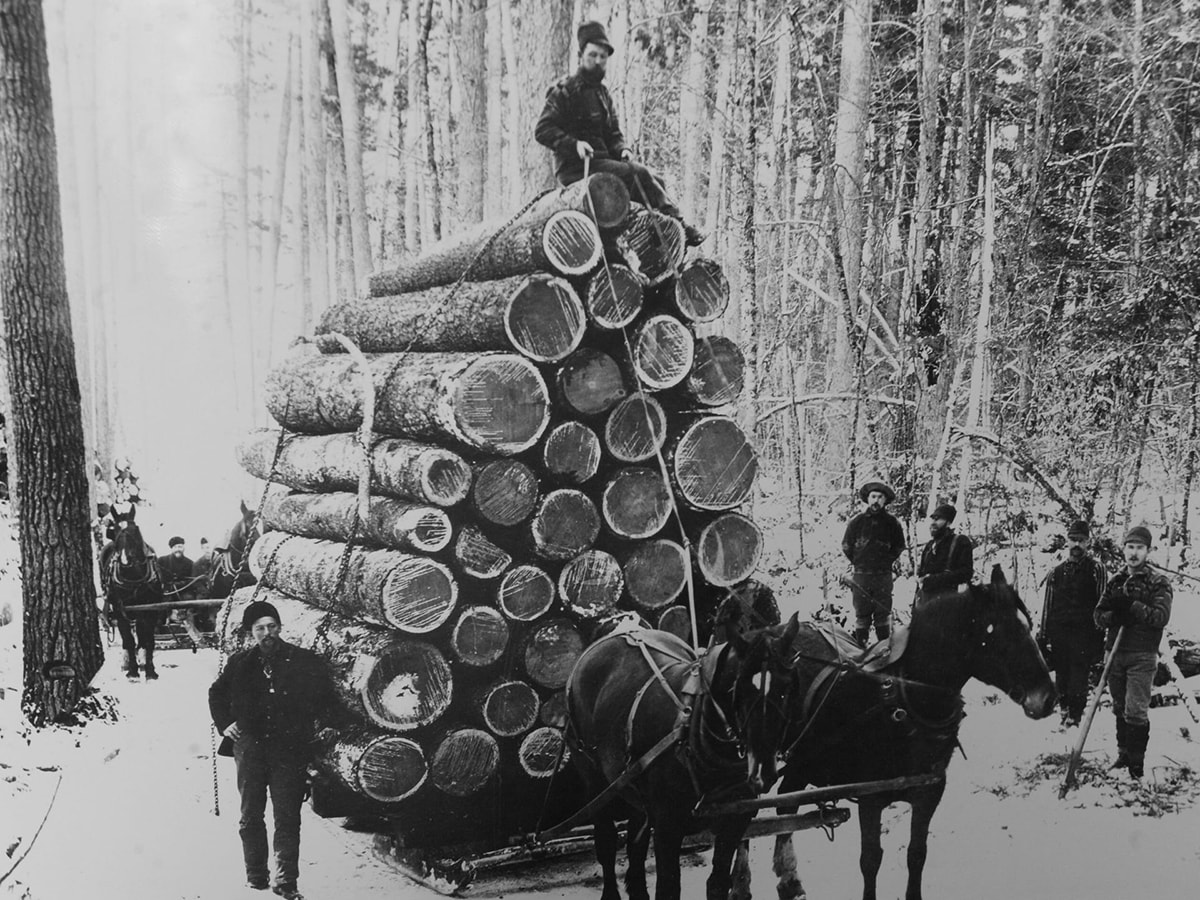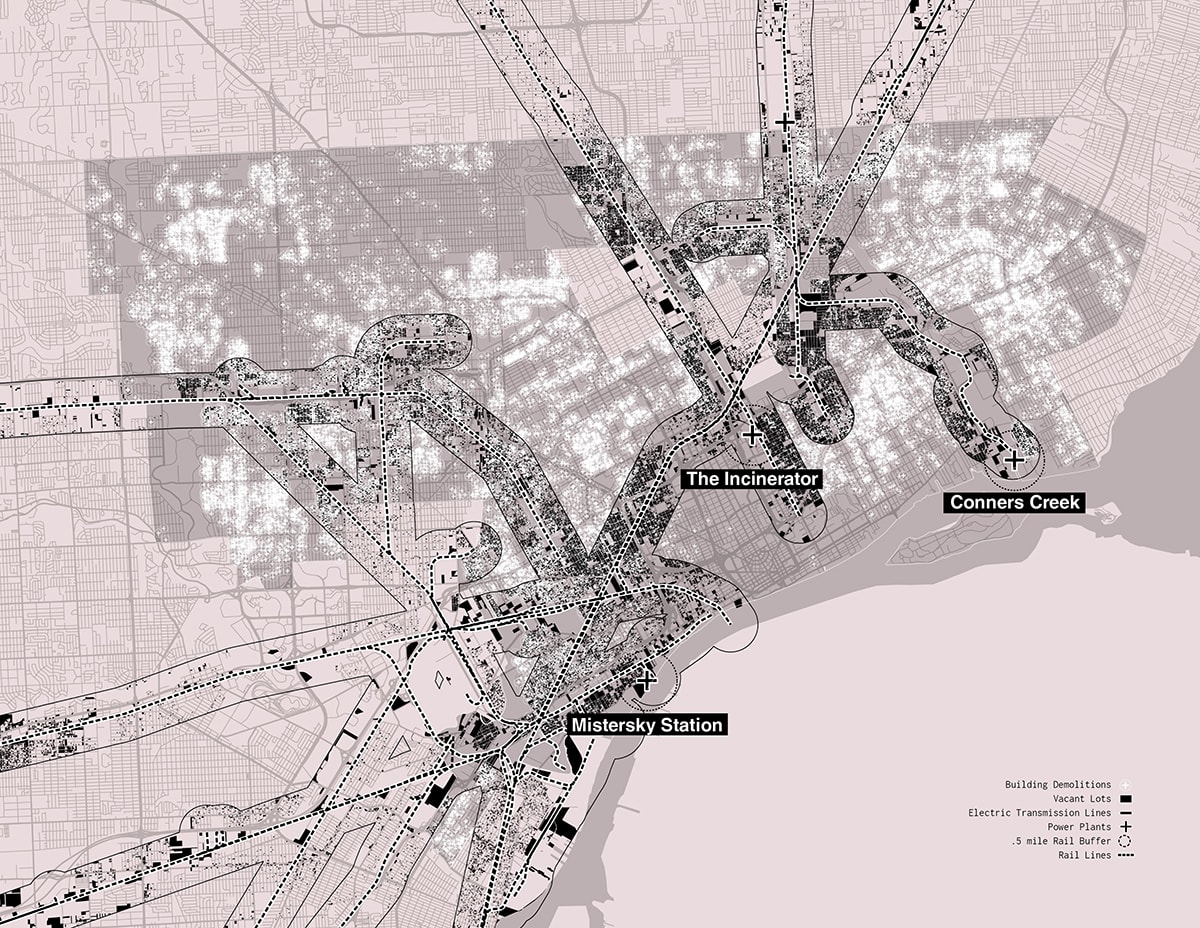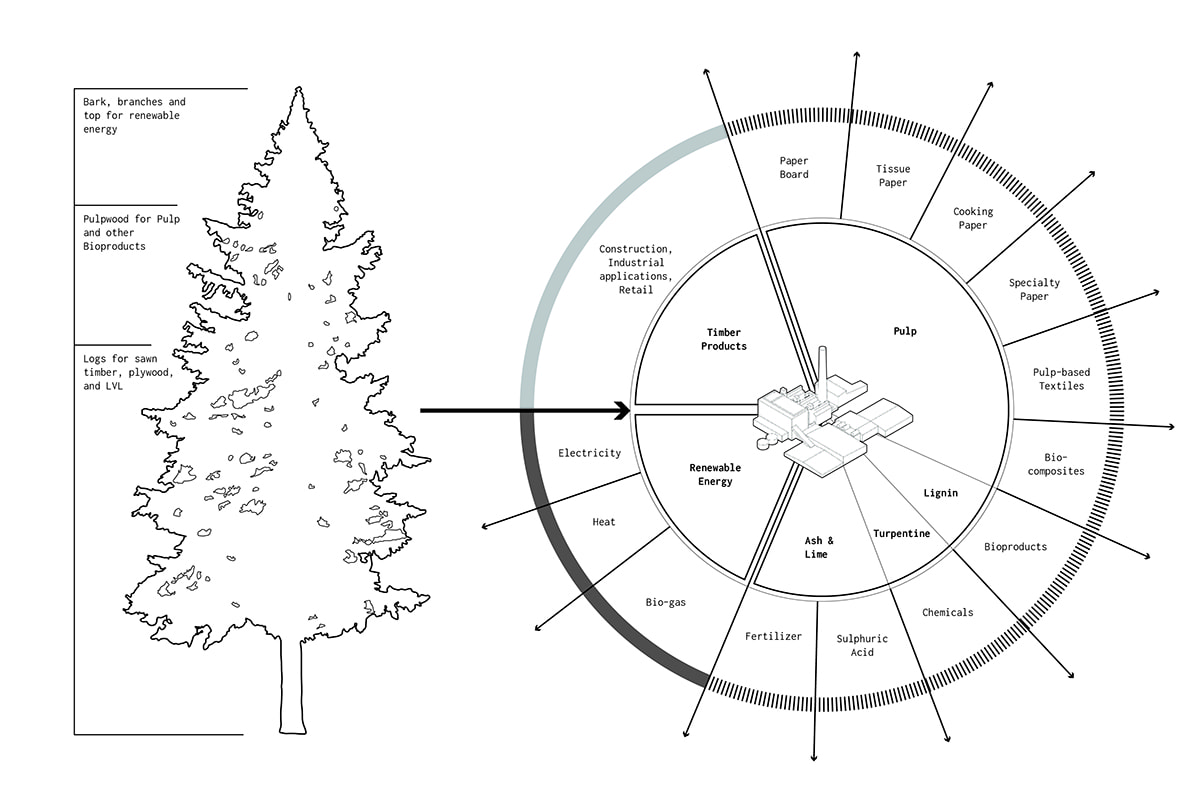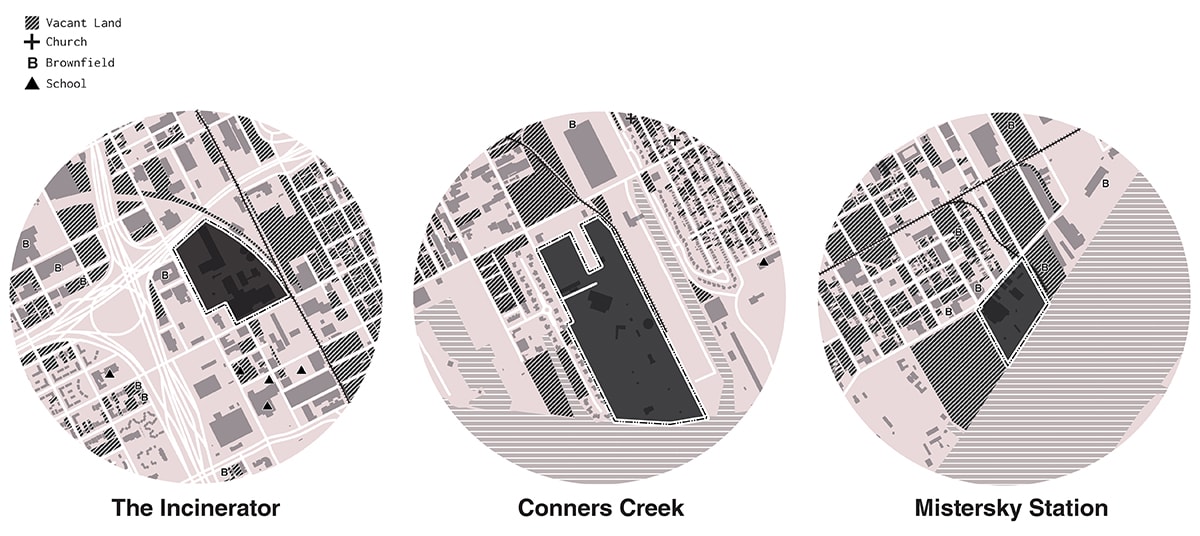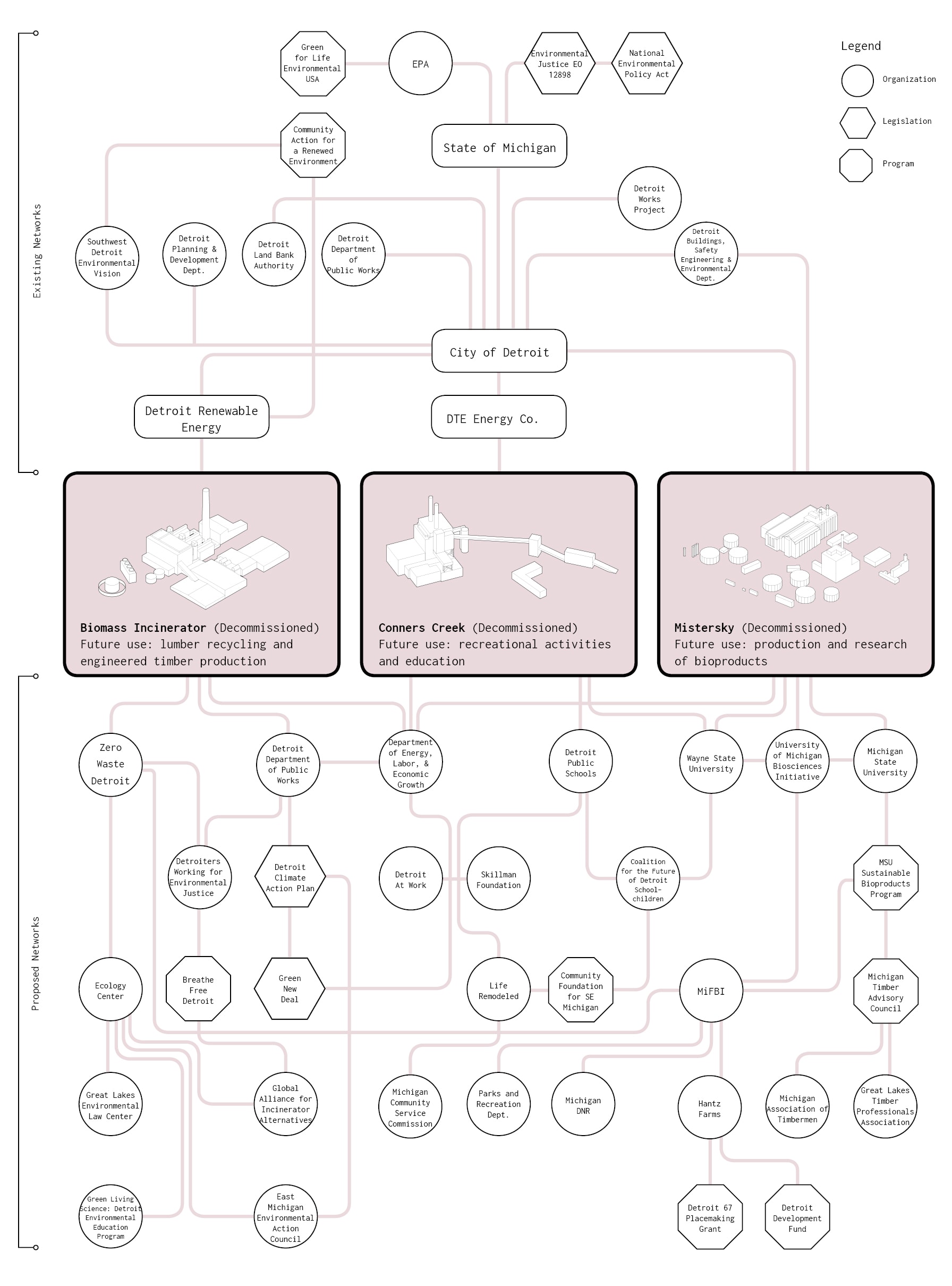Scattered throughout Detroit are relics of the city’s industrial production, along with the old generators of power for that industry. As Detroit’s population fell, as its energy demand declined, and newer energy technologies supplanted older ones, power generation in the City of Detroit has shifted from the city proper to its hinterlands. Power Plant Power investigates the ascendance of Detroit through the lens of energy production, its subsequent decline, and the potential inflections that could position the city to embrace new futures of alternative modes and dynamics of power.
This proposal does not intend to add a new power plant or create new methods of generating electricity, but rather to consider a paradigm shift in the power structures that control the distribution and consumption of energy within the city [1]. In this instance, power is viewed as a double entendre, where power as electrical generation is considered alongside resultant power dynamics that have impacted the surrounding built environment. In the midst of emerging modes and dynamics of power, how can Detroit reimagine energy production as a decentralized process that leverages the distinct characteristics of the city?
Starting in the 1860s and for the next 40 years, Michigan was synonymous with pine lumbering, a dangerous and lucrative business. Image courtesy of Detroit News Archives.
By reconsidering the role of Michigan’s natural resources in this contemporary moment, this proposal also seeks to create an influx of opportunities in the city. What if energy production facilitated methods of production and creation, where the resulting products could be utilized by resident stewards and surrounding communities? As a way of conceptualizing alternative modes and dynamics of power, this project intends to investigate spaces of electrical generation and power infrastructure that no longer function in their original capacity. Detroit’s decommissioned power plants and their surroundings, located along riverfronts and major transit infrastructure, serve as the spaces of speculation.
Lumber Catalysis
Detroit’s ascendance in the early 20th century was tied to an expansive history of capitalizing on the abundance of its forest ecosystem [2]. Detroit owes its initial wealth in large part to the timber trade, with timber barons overseeing the harvesting of the great Michigan white pine forests [3]. Beginning in the mid-19th century, white pines became the most desired tree species of the Great Lakes states. It was not long until Michigan became the leading producer of lumber in the United States, a title that it held into the early 20th century.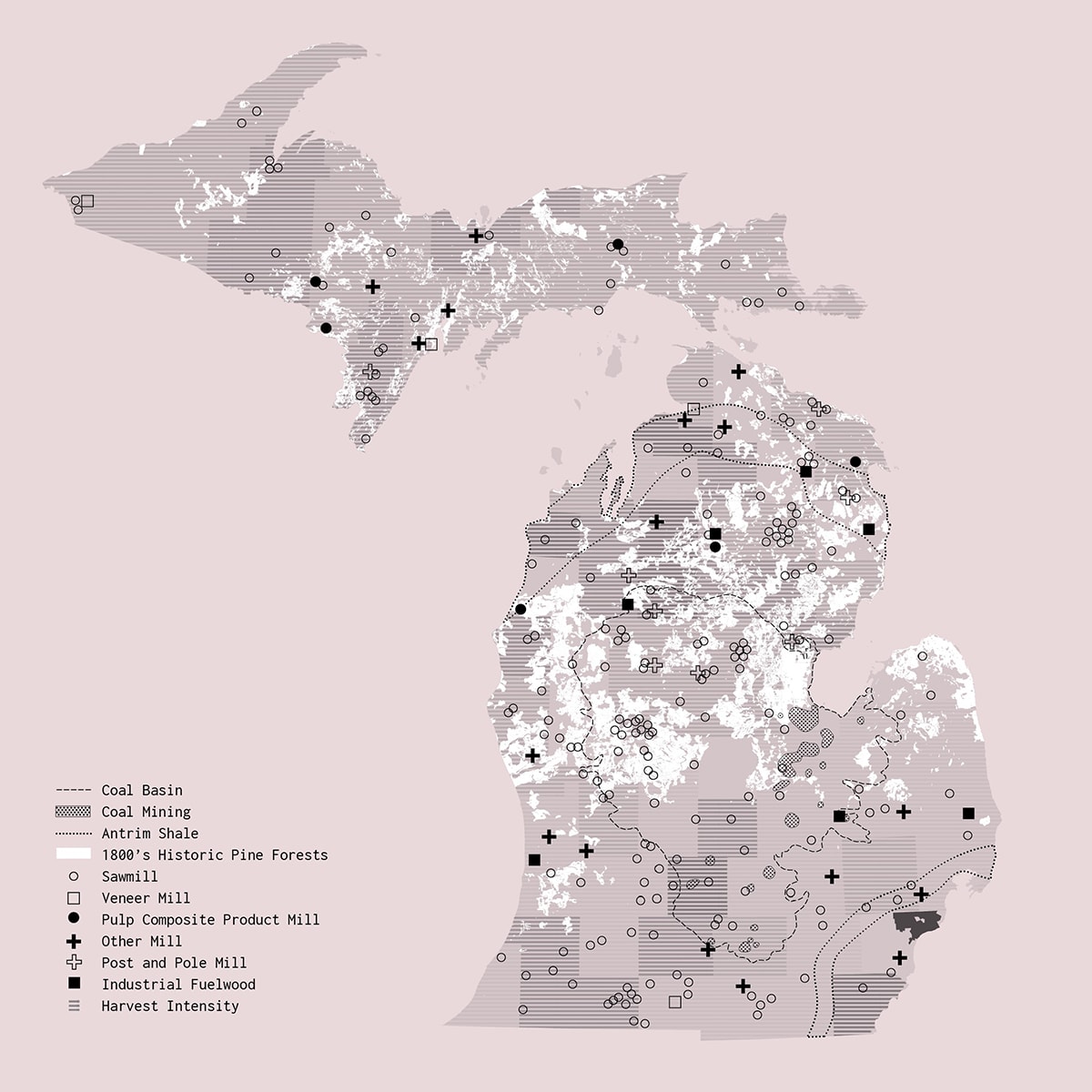
Historic white pine land coverage and raw resource extraction sites.
As the wealth extracted from Michigan’s forests accumulated, these business magnates turned their attention towards the next great export from Michigan — the automotive industry. This shift in capital from forestry to car manufacturing created a need for new methods of power generation, and in 1903 the first power plant began construction: the Delray 1, built by the Detroit Edison Company and projected to supply up to 6,000 kilowatt generating capacity, enough to power all of Detroit for the next twenty years [4].
The sudden influx of electricity facilitated the urbanization and culture of Detroit in a significant way. From towering arc lights to electric streetcars, Detroit established itself as a place of high culture, a civilized city with burgeoning new-age amenities. This was soon followed by rapid urbanization and the sprawling expansion of the city’s infrastructure. Today, the city has significantly reduced the amount of power generation within the city limits, and the low-density, de-urbanized landscape has begun to strain under the maintenance of this vast power grid.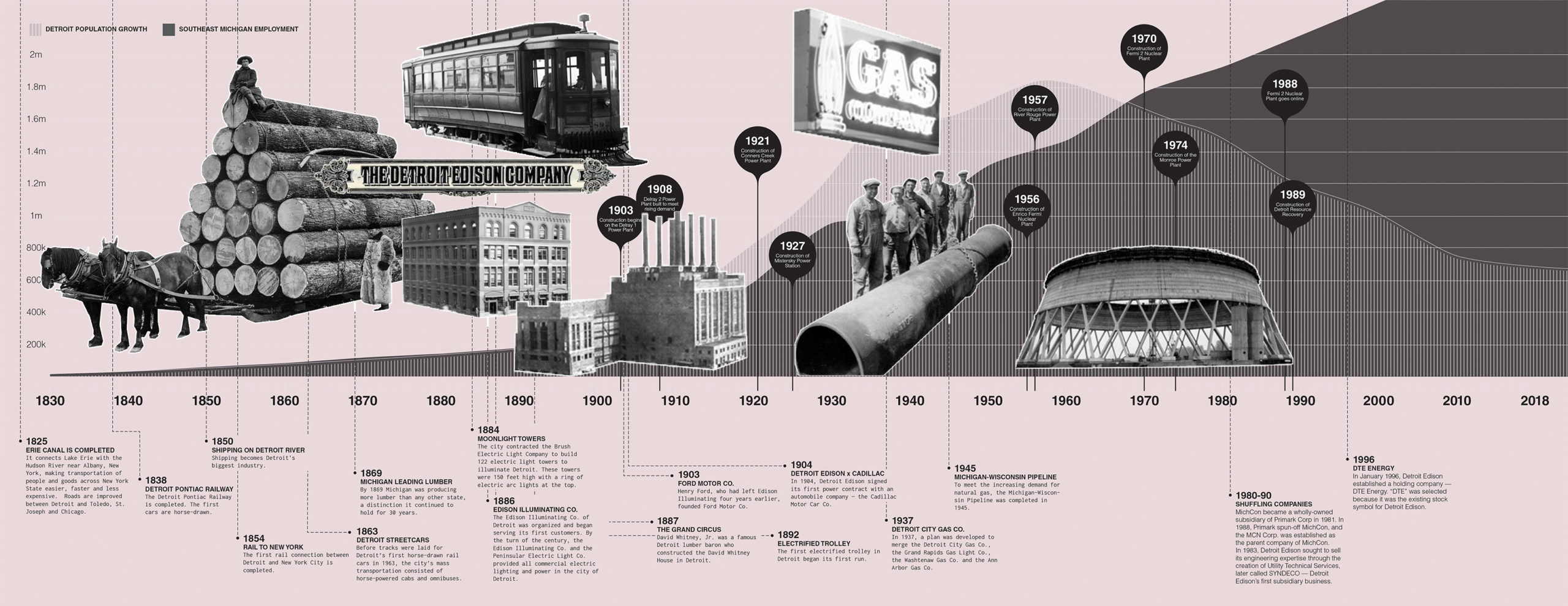
Timeline of Detroit’s industrial growth and energy production.
Energy + Growth
The massive facilities of energy production were situated along major waterways and railways; easy access to raw materials was the determining factor in carving out industrial zones within the city. Urban theory has grappled with the role of such infrastructural conduits on the form and development of the city. Infrastructural urbanism focused on the material expression of “networks,” many of them logistical supply connectors and infrastructural nodes such as ports, airports, and rail yards. Gabriel Dupuy’s essay, “A Revised History of Network Urbanism,” articulates the conceptualization and study of network theory that underlies the physical infrastructural systems that we are all familiar with. His characterization of topological, kinetic, and adaptive, frames the shift from centrality to nodal systematic organization of our cities [5].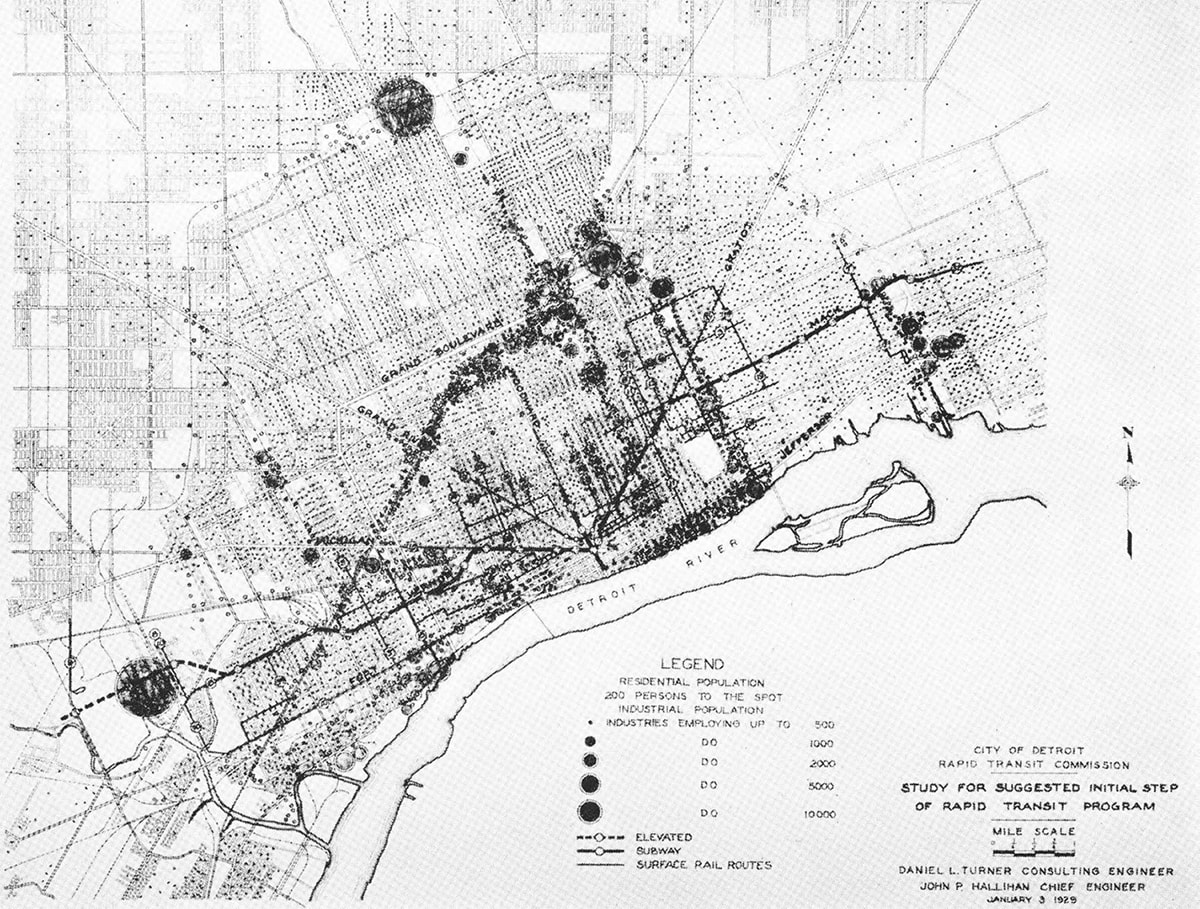
Report of the Street Railway Commission and the Rapid Transit Commission to Hon. John C. Lodge, Mayor, and Hon. The Common Council on a rapid transit system for the city of Detroit. Detroit, MI: Street Railway Commission.
The shift towards network urbanism serves to explain the state of our contemporary cities, as does a long-standing set of policies invested in the project of decentralization. At the time, notable figures such as Frank Lloyd Wright imagined a democratizing utopian potential in radical decentralization, best captured in his “Broadacre City” project, and actually perceived the dense metropolis as an antiquated mode of living. Furthermore, the expansion of industry to cheaper and larger pieces of land created linear cities that expanded the geographic reach of power supply, which focused on swaths of land within a certain proximity of the existing rail lines, which in turn served as connections to other industries and to electricity. These rail lines were the basic determinants of the location of Detroit’s automobile production in 1929 [6].
Nevertheless, electrical production continues to move towards the peripheries of the city. Power plants that used to run primarily on coal have either closed down or converted to cleaner methods of energy generation [7]. This transition is occurring not only in Detroit, but also statewide and even globally. For example, over the last decade, Michigan has more than halved its coal-fired power generation from 66% to 32% and doubled its renewable energy output from 4% to 10% [8, 9].
Population densities and power grid in Detroit.
It should come as no surprise that with more than half of the state’s land area covered by forest, Michigan has abundant woody biomass resources. In 2017, biomass power accounted for 16% of the renewable power generation in the state [10]. While that figure might not seem like a significant quantity with respect to coal, natural gas, and nuclear energy production, it is a vital piece of Michigan’s renewable energy portfolio.
While biomass energy production has been widely classified under the umbrella of “carbon neutral” or “renewable” sources of energy production (in the European Union, for example), not all forms of biomass are created equally. The capitalization of wood waste as an energy source has been discussed as being a more sustainable approach to biomass energy production, as contrasted with the more extractive practices of harvesting entire forests for the sole purpose of incineration. In 2014, the U.S. Environmental Protection Agency (EPA) found that “carbon neutrality cannot be assumed for all biomass energy a priori [11].” It should be noted that biomass energy producers in Michigan do not harvest trees specifically for energy. According to Michigan’s biomass trade group, biomass fuel is sourced from “wherever clean, sustainable wood waste is generated, forest to factory, cradle to grave. Biomass power generation provides a market for wood and alternative fuels that wouldn’t exist otherwise [12].” Just like forests initially provided the biomass that built Detroit’s initial wealth, sustainably sourced biomass could and should become a much bigger piece of the city’s energy picture.
Industrial Artifact
Perhaps the biggest transformative factor in Detroit in the early 20th century was the brainchild of Henry Ford. The Fordist methods of production afforded a new scale and magnitude to industry, which indelibly left its mark on the urban fabric through the building of magnificent industrial architecture and infrastructure. The infrastructural markers of the city, like that of the Mistersky Power Station, displayed admiration in its architectural details, machinic assemblage, and monumental verticality.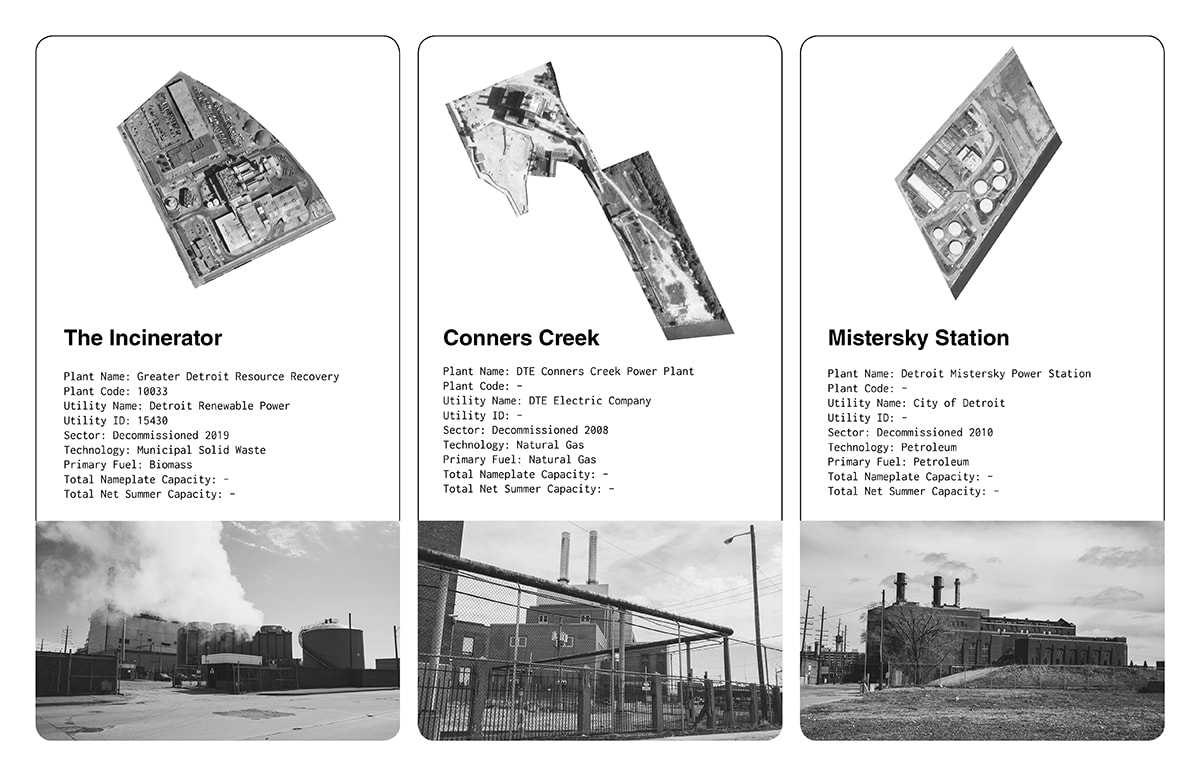
Three of Detroit’s decommissioned power plants that now sit in obsolescence.
Today, the Mistersky Plant, along with several other plants, sits in magnificent obsolescence, unable to contribute to the Detroit power grid. The imagery of these decommissioned stations conveys the “patinated confections” emblematic of ruin porn, while a barbed wire fence encloses the once-productive symbol of burgeoning technological progress [13]. This six-story brick coal-fired power station was originally constructed in 1927, but the high costs of modernization to keep up with market rates for energy production led to its decommissioning in 2010 [14].
The most recent removal of antiquated power production is the closure of the Detroit Incinerator. This “renewable” energy plant was first developed in the 1970s, and for decades has been a central flashpoint of environmental justice protests in the city, becoming both a stink hole and taxpayer sinkhole for the residents of Detroit. According to the Detroit Metro Times, “before the plant was even paid off, the city sold it to a private owner in 1991 for a mere $54 million. Only in 2009, 20 years after the facility opened, did Detroit pay off the tab, which, including interest, amounted to at least $1 billion [15].” This expenditure of Detroit’s tax dollars going toward a polluting nuisance is no longer; the plant officially closed in March of 2019. The site is primed for a transformation from a community plague to a center of community growth and could be reimagined as a hub in the agroforestry and recycling industry, poised to transform the power dynamics in the city of Detroit.

Residents of Detroit Protesting Detroit Incinerator (1986-1990). Image Courtesy of Millard Berry.
Bio-Tracts
The vacancies of the city are ripe for revaluation. By utilizing the existing energy infrastructure components that include railroad lines, major trucking routes, and waterfront access, the Power Plant Power proposal establishes a new system of cultivation that would transform the consumption and production of energy in the city of Detroit. Through a re-utilization of existing infrastructures, agroforestry and alternative productive landscapes could catalyze a new system of alternative energy production. This radical rethinking of production can act as a method of co-generation and creation, where the resulting physical materials could be utilized by resident stewards and surrounding communities.
Map showing Detroit’s major rail lines and highlighting the vacant properties available as potential bio-tracts within 1/2 mile radius of the existing rail line.
Over the last century, Detroit has faced immense population decline, with nearly a third of its 139 square miles becoming vacant [16]. This phenomenon can be seen throughout the residential fabric of the city, with many homes sitting in isolation, surrounded by unkempt lots and emerging woodlands reclaiming the vacant landscapes. These vacant parcels are associated with crime and illegal dumping, putting a strain on the city’s limited police and fire resources [17]. Not only can agroforestry provide a means for stabilizing the economic strain of massive vacancies, but the productive management of the land by resident stewards can provide a means for building capital.
Energy outcomes of agricultural products cultivated from the bio-tracts.
The potential of agricultural products is vast and diverse. In order to speculate on future possibilities, the proposal highlights three potential outcomes: bioproducts and their accompanying bioresearch, engineered timber products for construction, and recreational activities and community facilities.
Plant Power
In this proposal, the decommissioned power plants, now benefit new forms of cultural production. They become spaces for the public, where material production and the resulting communal programs sit on display for appropriation and use by the residents of the city.
Half-mile radius documenting the surrounding context of the decommissioned power plants in Detroit.
Mistersky Station, Conners Creek Station, and the Incinerator have the potential to be reimagined as neighborhood institutions that build local community empowerment through public education programs, employment, and research. Where they once stood as megalithic symbols of industry, they can now serve as beacons for local communities. By leveraging new forms of agro-production, these centers can house concurrent neighborhood development programming to provide residents with the tools necessary to maximize the economic and ecological potential of their sites.
Actor Network map detailing possible outcomes of decommissioned power plants acting as facilitators and generators of new power production.
At the same time that it radically rethinks energy generation in the city of Detroit, this proposal seeks to account for past agricultural traditions and to provide a more holistic approach to the concept of power and production. The systems that are created through this paradigmatic shift strive to disrupt the forces that maintain power in the city of Detroit, re-establishing new networks of power around physical entities that are both renewable and regenerative — pieces of infrastructure that serve not as abstract powerhouses of industrial production, but new nodes of local empowerment.
Acknowledgements
We would like to acknowledge Associate Professor Geoff Thün and his seminar Scripting Future Urbanisms at Taubman College of Architecture and Urban Planning for providing the framework from which this proposal was conceived. We would also like to acknowledge María Arquero de Alarcón for her guidance in helping to develop this research into Salvador Lindquist’s graduate thesis, Incinerator Incorporated.
 Salvador Lindquist is an urban designer and a licensed landscape architect with several years of experience in practice operating on projects at a multitude of scales. From regional planning to site design, Salvador’s academic and professional career to date interrogates how urban interventions can be better situated within the larger systematic context of our cities and regions. Currently a Master of Urban Design candidate at Taubman College, his research interests explore emerging modes and dynamics of power in the transformation of the urban landscape with a particular focus on post-industrial cities. After graduation, Salvador will be a lecturer in landscape architecture at his alma mater, the University of Nebraska-Lincoln.
Salvador Lindquist is an urban designer and a licensed landscape architect with several years of experience in practice operating on projects at a multitude of scales. From regional planning to site design, Salvador’s academic and professional career to date interrogates how urban interventions can be better situated within the larger systematic context of our cities and regions. Currently a Master of Urban Design candidate at Taubman College, his research interests explore emerging modes and dynamics of power in the transformation of the urban landscape with a particular focus on post-industrial cities. After graduation, Salvador will be a lecturer in landscape architecture at his alma mater, the University of Nebraska-Lincoln.
 Eric Minton is a designer whose work focuses on finding solutions to complex architectural and planning problems, specifically focusing on how the ideological and aesthetic implications of architectural rehabilitation influence community engagement and development. Eric received his Master of Architecture and Bachelor of Science in Architecture from the University of Michigan Taubman College of Architecture and Urban Planning. Eric has also studied at Les Ecoles d’Art Américaines de Fontainebleau where he focused on hand-drawn studies of the renowned Fontainebleau Château and its magnificent formal gardens. He is currently a Project Designer at AOS Architects in Philadelphia, Pennsylvania with a focus on historic preservation and the rehabilitation of industrial buildings into new housing stock.
Eric Minton is a designer whose work focuses on finding solutions to complex architectural and planning problems, specifically focusing on how the ideological and aesthetic implications of architectural rehabilitation influence community engagement and development. Eric received his Master of Architecture and Bachelor of Science in Architecture from the University of Michigan Taubman College of Architecture and Urban Planning. Eric has also studied at Les Ecoles d’Art Américaines de Fontainebleau where he focused on hand-drawn studies of the renowned Fontainebleau Château and its magnificent formal gardens. He is currently a Project Designer at AOS Architects in Philadelphia, Pennsylvania with a focus on historic preservation and the rehabilitation of industrial buildings into new housing stock.
Notes
[1] Meadows, Donella. “Leverage Points: Places to Intervene in a System.” http://donellameadows.org/wp-content/userfiles/Leverage_Points.pdf.
[2] Schaetzl, Randall. “White Pine Logging: A Background.” Accessed April 17, 2019. http://geo.msu.edu/extra/geogmich/loggingbackgrd.html. Vast tracts of white pine, ideal for the production of construction lumber, are naturally abundant in Michigan.
[3] Schaetzl, Randall. “White Pine Logging: A Background.”
[4] Bragg, Amy Elliott. “How the Rise of Electricity Transformed Urban Life in Detroit.” Model D, July 15, 2014. https://www.modeldmedia.com/features/detroit-energy-history071514.aspx.
[5] Dupuy, G. (2000). A revised history of network urbanism. Network Urbanism, OASE, (53), 3–29. Retrieved from https://www.oasejournal.nl/en/Issues/53/ARevisedHistoryOfNetworkUrbanism
[6] Fishman, Robert. “Detroit: Linear City.” In Mapping Detroit: Land, Community, and Shaping a City, 77-99. Detroit, MI: Wayne State University Press, 2015.
[7] Fleming, Leonard N. “DTE Energy Speeds up Closing of Coal-Fired Plants.” Detroit News. The Detroit News, March 29, 2019. https://www.detroitnews.com/story/news/local/michigan/2019/03/28/dte-energy-speeds-up-closing-coal-fired-plants/3303608002/.
[8] Michigan Energy Overview, Michigan Energy Overview § (2011). https://www.michigan.gov/documents/energy/michigan_energy_overview_605784_7.pdf.
[9] “U.S. Energy Information Administration – EIA – Independent Statistics and Analysis.” Michigan – State Energy Profile Overview – U.S. Energy Information Administration (EIA), May 16, 2019. https://www.eia.gov/state/?sid=MI#tabs-4.
[10] “Michigan Biomass.” Michigan Biomass, February 2019. http://www.michiganbiomass.com/.
[11] Cho, Renee. “Is Biomass Really Renewable?” State of the Planet. Earth Institute Columbia University, October 19, 2016.
[12] “Michigan Biomass.” Michigan Biomass, February 2019. http://www.michiganbiomass.com/.
[13] Clutter, McLain. “Notes on Ruin Porn.” The Avery Review | 18. October 2016. https://averyreview.com/issues/18/notes-on-ruin-porn.
[14] Bragg, Amy Elliott. “How the Rise of Electricity Transformed Urban Life in Detroit.” Model D. Accessed April 24, 2019.
[15] Jackman, Michael. “Why the Detroit Incinerator Is Costly, Dirty, Smelly, Dangerous – and Unnecessary.” Detroit Metro Times. Detroit Metro Times, August 11, 2019. https://www.metrotimes.com/detroit/why-the-detroit-incinerator-is-costly-dirty-smelly-dangerous-and-unnecessary/Content?oid=11022315.
[16] Associated Press,”Survey: A Third of All Detroit Lots Are Vacant or Abandoned,” MLive,February 20, 2010, https://www.mlive.com/news/detroit/index.ssf/2010/02/survey_a_third_of_all_detroit.html.
[17] David Lepeska, “Is Blotting the Best Solution for Shrinking Cities?” CityLab,November 10, 2011, http://www.citylab.com/equity/2011/11/blotting-good-or-bad-shrinking-cities/470/.
Cite
Salvador Lindquist and Eric Minton, “Power Plant Power,” Scenario Journal 07: Power, December 2019, https://scenariojournal.com/article/power-plant-power/.

